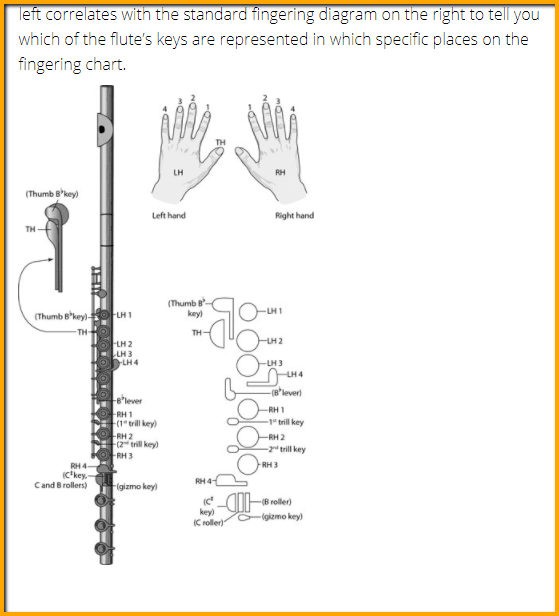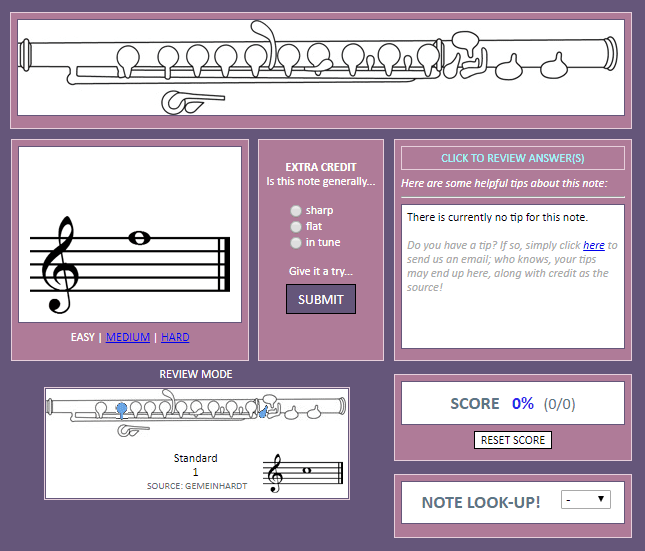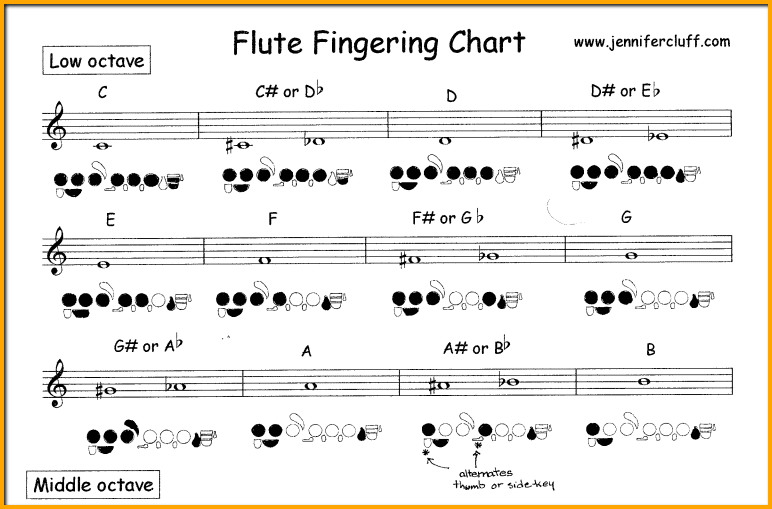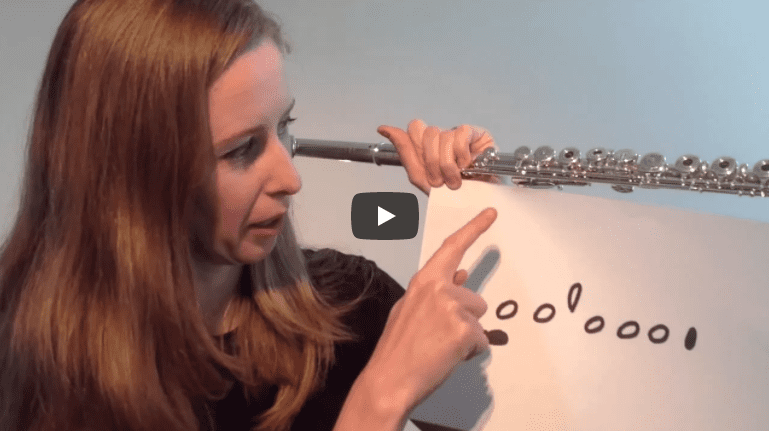
Looking for a quick and easy way to learn flutenotes for beginners? You’ve found the quintessential guide on how to read music notes for flute.
As you start to become more familiar with the flute, you’ll naturally become interested in learning more note positions. Every new player has a goal of learning all of the flute notes, no matter what style of flute they’re looking to play.
It’s important to learn how to read music notes for flute as soon as you can—the sooner you learn them, the sooner you can read sheet music and master different melodies.
Learning flute notes can also help you improve on specific elements of your technique that are crucial to getting off to a good start. You’ll start to see your posture, the way you hold the flute, and your embouchure all improve with practice.
Proper Posture for Learning Flute Notes
Speaking of posture, there are a few key things you should remember to help you learn how to play flute notes comfortably. First, let your fingers curve over the top of your keys using the least amount of tension, without feeling like you’ll drop the flute.
Don’t try to grip the keys or put your fingertip right on the key. Instead, let your whole hand hold the flute, and remember that your fingertip is simply an extension of your finger that originates near the wrist. Proceed slowly, and try to eliminate any unnecessary tensions as you play.
As you learn the flute for beginners basics, try to release and relax your elbows and shoulders, which are two areas that often try to “help” as you play. Lastly, learn to keep your fingers close to the keys—don’t let them fly away with each change of note! This is referred to as “economy of motion.”
How to Learn All Flutes Notes Quickly

Here are the steps you can follow to learn flute notes for beginners, as easily and quickly as possible. Take your time with each pointer, and see if you can apply these tips to your daily practice time. After we explore how to read music notes for flute, we’ll discuss ways you can put these notes into practice and start memorizing them. Then, you can work on playing any song you like!
Commit to One Note at a Time
Each note has specific keys that need to be pressed and trying to learn all the notes at the same time can be overwhelming! Commit to one note at a time and continue to review the ones you’ve already learned. Eventually, you won’t even need to think about where your fingers need to go!
Create Associations for Each Note
In the beginning, each note configuration can seem random. Try to make a specific association for each note so you can easily recall it. Some note memorization tricks are passed down from teacher to student, while others are personalized to a particular flutist. Come up with note associations that are easiest for you to remember!
For example, for B flat, you can think of it as “pinchers” – you only press down your left index finger and thumb keys and your right index finger key (plus your right pinky finger key). This creates an image of pinching between your index fingers and thumbs.
Learn Flute Notes in a Logical Order
It’s a smart idea to start by learning the notes of a scale, such as the B flat major scale. This includes the notes B flat, C, D, E flat, F, G, A, and then an additional B flat. Starting with the B flat major scale makes it easier to understand the music theory behind what you play. You can start moving onto other scales and keys after getting down this fundamental flute scale.
Other options for your very first notes are A, B flat, and C (all on the staff). A has four keys depressed. To switch to B flat, lift up your left third finger and press down your right index finger. Then for C, lift up your left thumb and your right index finger.
Double Check the Fingering
Beginners often make errors in the fingering of notes. Sometimes, the difference in sound of pressing an extra key is very subtle. However, over time this makes a big difference, not just sound-wise but also technique-wise. To avoid learning the wrong fingerings, double check a fingering chart as you learn flute notes.
Tips for Memorizing & Practicing Flute Notes
- A large part of memorizing flute notes has to do with muscle memory. This is why it’s important to practice good posture habits as you learn notes, because you’re creating a habitual pattern in your muscles for how to play each note. Make this new muscle memory a good one!
- Use your brain to solve puzzles on the flute. Lots of musical learning can happen away from your instrument. Just by thinking about playing different note fingerings on the flute, you’re building valuable mental associations. Spend some time visualizing all of the flute notes throughout your day, and you’ll notice a difference when you pick up your instrument!
Print out some blank flute fingering charts and use a pencil to darken the keys you would depress for each note. This type of visual memory practice can cement what your muscles are already learning.
- Once you feel comfortable with your memory of the notes, start to practice very simple melodies that you can find in a beginner method book. This will strengthen your memory even more, and train your ability to switch between notes smoothly and comfortably.
Practicing this way also improves your breathing and stamina. As you read the music, you’ll be reinforcing a trifecta of musical knowledge: the fingering for the note, its printed placement on the musical staff (what line or space it appears on), and its name (D, E flat, or F, for example).
- Remember to set specific and realistic goals for yourself. Once you’ve learned all the notes in a specific scale, set a long term goal to learn all the flat or sharp notes. Then ultimately, you can try to master the chromatic scale.
Cheat Sheets for Learning Flute Notes
The best way to learn beginner flute music notes is by reinforcing your knowledge in a variety of ways. Check out the following five sites that offer cheat sheets and helpful charts on mastering flute notes for beginners. Get ready to increase your learning speed, while making flute practice more fun!
- Flute for Dummies – This page covers learning which hand goes where, as well as finger placement. It also includes a complete fingering chart. In the beginning, you’ll learn the middle range of notes and over time, you can learn the lowest and highest notes.

- Flute Fingering Trainer – Test your flute for beginner note knowledge here! You can select your desired level (easy, medium, or hard) and then identify each note by clicking on the keys of the flute. This will help you learn and reinforce the knowledge you already have.

- JenniferCluff.com – This is a complete fingering chart, in order from lowest to highest notes. You can start by learning the first A listed (in the low octave) and continue upwards to the A that is one octave higher.

- 8notes – This website covers learning all of the flute notes from start to finish. It features a color-coded guide for putting each finger on the right key. Check it out as a precursor to learning your first flute notes and then advance to “Part 8.”

- Jane Cavanagh Flute School – Watch this two-minute video to see a visual description of how to read an easy read flute finger chart. Then follow the tips on how to learn flute notes for beginners, too!

Now that you know how to learn flute notes, you have access to an entire world of flute music! Follow the suggestions above and it will be an enriching process to increase your knowledge and flute abilities. There is a wide range of resources available to beginning flutists, including books, YouTube teachers, and online guides, such as this one. By far, the best way to improve your flute skills is through private flute lessons.
An experienced flute teacher can observe your progress, correct mistakes, and provide personalized suggestions for what to learn next. Remember to enjoy the journey, and before you know it – you’ll know all the notes!
 Post Author: Nadia B.
Post Author: Nadia B.Nadia B. teaches flute in New York, NY, and also teaches online lessons. She acted as principal flutist of the orchestra and wind ensemble at California State University Sacramento, and then went on to receive her degree in Music Performance from New York University. Learn more about Nadia here!
Jessica Dais

